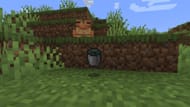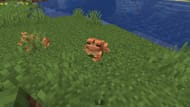Minecraft 1.19, The Wild Update, added many new and exciting features to the game, including the terrifying Ancient City, protected by the powerful warden. The new mangrove swamp is made of mud that can be turned into mud bricks and the allay, which will follow the player around and collect items for them.
The most adorable addition to 1.19 is the frog, along with its baby form, the tadpole, and the egg, the frogspawn. Because frogs have both an egg form and a separate larval form, their life cycle can be pretty confusing.
Minecraft: Frogspawn

A frog produces a frogspawn after two frogs mate. It is placed on the nearest water block to the frogs with air above it, which the pregnant frog will enter, lay the frogspawn, and then exit the water. Frogspawn can take up to 10 minutes to hatch, and between two and five tadpoles will spawn when the frogspawn breaks during hatching.
Frogspawn is an unobtainable item for survival players, even when attempting to break it with a silk touch enchanted item. If broken, nothing will drop.
Tadpoles

Tadpoles are the larval form of frogs. They are one of the only mobs in the game with a different baby form than its adult form, as tadpoles and frogs are considered different mobs. Tadpoles can only spawn from frogspawn and will never naturally spawn.
As with other baby mobs in the game, tadpoles do not drop experience on death. If they end up out of the water, they will flop around attempting to reach the nearest water, though they die quickly. Axolotls will hunt tadpoles.
Tadpoles can be moved in two ways. They can be led through water by players holding a slimeball, or players can collect them in a water bucket to manually transport them over land. Tadpoles take 20 minutes, or a full Minecraft day, to grow into a frog, though this can be sped up by feeding the tadpole slimeballs. Each slimeball will reduce the time spent as a tadpole by 10%.
Frogs

There are three different colors of the frog. There is the temperate orange, the green cold, and the warm white frog. Each of these frog colors is associated with a different biome temperature. Cold frogs are associated with frozen, snowy, and icy biomes. Warm frogs are associated with deserts, badlands, swamps, and temperate biomes with regular temperature biomes.
The color of a frog does not depend on the location of the frogspawn. The frog’s color is instead associated with the biome that the tadpole was in when it grows into a frog. Frogs can breed if the player feeds them both a slimeball. After breeding, one frog becomes pregnant and will move to the nearest water source block with air above it to lay a frogspawn.
A frog eating a small magma cube will drop a frog light. There are three different colors of frog light, one for each color frog. Frogs can be found naturally within swamps, both mangrove and regular varieties.
Frogs can jump up to eight blocks high and take five fewer hearts of fall damage than all other mobs. Frogs prefer jumping on lily pads and big dripleaves. However, they are unable to jump on honey blocks.
Frogs prefer jumping up to higher elevations compared to their current level, though they will not prioritize the highest spot they can find, just any higher than where they currently are.
Obsessed with Crosswords, Wordle, and other word games? Take our quick survey and let us get to know you better!
